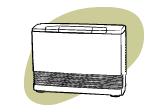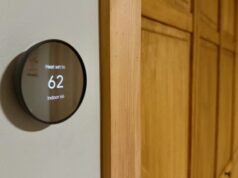
Gas heaters are reasonably efficient, cheap and environmentally friendly, and require little maintenance to keep them up and running.

The first gas heaters operated in the same way as a Bunsen burner – you turned on the gas supply and then lit a match. Nowadays the way gas heaters operate involves a much safer, easier and more sophisticated process. Because they are considered to be quite efficient, gas heaters are common in Australia, particularly in areas where gas piping (also called ‘gas reticulation’) is available to the home. Gas heaters take many shapes and forms, and in some cases are designed to look every bit like a traditional fireplace.
Types of gas heater
Flued gas heaters
A flued gas heater is similar to a wood heater in that it is a permanent fixture in your home. The ‘flue’ is a type of chimney system that allows fumes to be exhausted outdoors. These types of heaters are generally the larger of the two, and are used either as a space heater for a large living area, or as a central heating furnace which distributes warm air throughout the home through a series of ducts.
Tip
- Flued gas heaters are typically designed to heat an area of between 70-100m2.
Unflued (portable) gas heaters
A non-flued gas heater is a portable system that can be transported around your home. While convenient, if used incorrectly they can raise some very dangerous health issues. Because they don’t use a flue, the exhaust gases from non-flued gas heaters are released into the room. These heaters should never be used in a room without excellent ventilation, and even then may cause issues for people who are asthmatic or those with respiratory or allergic conditions. Using a non-flued gas heater in a small, poorly ventilated area can lead to carbon monoxide poisoning, which may be lethal.
Tip
- Unflued gas space heaters are typically designed to heat areas of up to 70m2.
How energy efficient are gas heaters?
Under the conditions of Australian Standards AS4553 and AS4556, gas heaters sold in Australia are required to feature gas energy labels that indicate their comparative energy consumption (based on a standard set of conditions), and which show a star rating (from one to six stars) that can be used to give the buyer a basic idea of how each particular system stacks up against others. The more stars on the label, the more efficient the heater is.
Installation requirements
The use of gas heaters in a home is tightly regulated, and requires compliance with a lot of Australian Standards to ensure your safety and the safety of your neighbours. In regards to the installation of permanent flued systems, flues must clear your roofline by a minimum of 600mm, and must be at least one metre taller than any neighbours within 15 metres of your property. The flue/chimney must also be of an appropriate for the size of the fire heater, and must be tightly sealed to prevent fumes from escaping back into your home.
Most states now have regulations regarding the installation of flueless gas heaters, so it is important to check with your state regulatory body before purchasing one.
Where do I put it?
Placement of a flued gas heater is a lot like a wood heater – it can go anywhere you want, as long as it is connected to a flue and has access to a gas connection. Flueless systems can essentially go just about anywhere too, but shouldn’t be put it in a room where you sleep.
|
Advantages
|
Disadvantages
|





